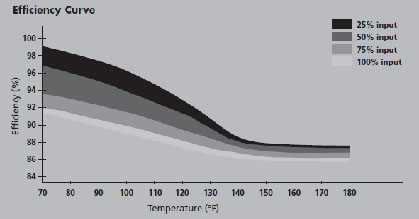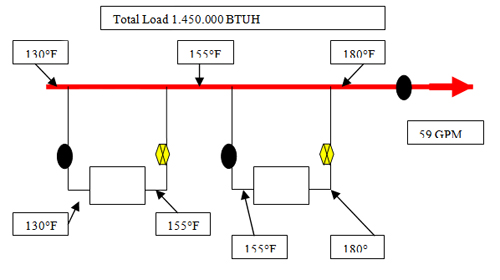| Printer Friendly (PDF)
Over the last several weeks we outlined the use of primary secondary systems for high ΔT hydronic heating systems. This article will address the use of Laars NeoTherm condensing boilers in high ΔT systems. The Laars boilers and water heaters are constant flow devices which mean a constant speed primary pump must be installed. The flow rate required allows temperature rises between 20°F and 30°F. If the secondary system has a higher ΔT we use two boilers in series to achieve the design condition. Let’s look at an example. Assume we have 1,450,000 BTUH with a 180°F to 130°F temperature range for a 50°F ΔT . Let’s use two Neotherm Boilers to do the job. At 130°F and 100% firing rate the efficiency shown on the chart below will be 87% and will require 1,450,000/.87 = 1,667,000 BTUH input. Two Laars Neotherm Model NTHB-850s will do the job nicely. The NeoTherm requires a ΔT of between 20 and 35°F. Our system requires 50°F so we will use each boiler at 25°F and pipe them in series. Each boiler will require a primary pump at 59 GPM. We arrive at this by taking the BTUH output of 850,000 X .87 = 739,500 BTUH divided by (500 X 25°F ΔT) for a flow rate of 59.16 GPM. The piping schematic will look like the following. Using two boilers in series for this system will provide both condensing efficiency savings as well as standby capabilities. Next week in our Monday Morning Minutes, we will discuss control strategies utilized for multiple boiler installations. |
 |
Thank you for using products sold by R. L. Deppmann Company in Michigan and Ohio!
Disclaimer: R. L. Deppmann and it’s affiliates can not be held liable for issues caused by use of the information on this page. While the information comes from many years of experience and can be a valuable tool, it may not take into account special circumstances in your system and we therefore can not take responsibility for actions that result from this information. Please feel free to contact us if you do have any questions.
Archives – Click here for Past Articles


